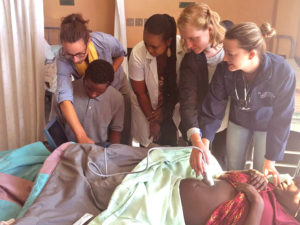
Photo: Dick Greene/Highlands University
Highlands graduate Molly Enenbach, left, and Highlands senior James Foster, seated, and New Mexico Tech graduate Zoe Diener, second from right, teach two medical students at the University of Namibia in Africa how to use a portable ultrasound device to locate the patient’s liver. The medical students are Charlotte Lilly, in the white coat, and Jacomy Schickerling, far right.
Las Vegas, N.M. – New Mexico Highlands University students are volunteering in Namibia, Africa, this summer teaching medical students and others how to use a revolutionary hand-held portable diagnostic ultrasound device that has the power to save lives.
Molly Enenbach, a 2016 Highlands biology graduate who begins medical school in August, and James Foster, a Highlands biology senior, are demonstrating how to use the low wattage device the size of a smartphone or computer tablet that is used to diagnose disease and trauma conditions.
Zoe Diener, a 2017 New Mexico Tech biology graduate and former student body president, also joined the Highlands team this summer.
“The most exciting aspect of teaching the Namibian medical students is seeing the changes that occur during their rounds at the Katutura State Hospital in diagnosing conditions,” Enenbach said. “We are able, along with the teaching doctor, to show the medical students immediately, right at the patient’s bedside, what the ultrasound showed.”
Enenbach, a 23-year-old from Aztec, New Mexico, who starts medical school at A.T. Still University in Arizona, said volunteering in Namibia has been a fantastic learning experience which Highlands prepared her well for.
“The staff at the University of Namibia Medical School are incredibly dedicated and inspirational, often working with limited resources ranging from medical devices to prescriptions. We see tuberculosis and AIDS patients daily, preparing me to see heartbreaking situations. I’m more motivated than ever for medical school and very thankful for this opportunity,” said Enenbach, the 2016 Highlands Student of the Year.
This is Enenbach’s second international medical experience. She founded the International Service Group at Highlands and was the lead organizer for the group’s medical delegation to Guatemala in May 2016.
Dick Greene, a longtime Highlands engineering and biology professor, developed and leads the Namibia project. He trained the New Mexico students in using the Point of Care Ultrasound device, POCUS for short. The device allows noninvasive and dynamic imaging of both normal and abnormal human internal tissues, organs and physiological processes. It is also far less costly than traditional full-size ultrasound devices.
“With the proper training, this portable imaging device can be used to to optimize medical triage by most all health care providers,” said Greene, a 2017 U.S. National Academy of Sciences Jefferson Science Fellow who has led a number of international medical aid projects. “When properly implemented, the device can reduce morbidity, mortality and costs. It’s dramatically changing the physical exam and patient management.”
In Namibia, which borders South Africa, trauma patients are often without imaging services. Diseases like TB, AIDS, malaria, and yellow fever pose serious public health problems. Greene’s team is working first with the University of Namibia School of Medicine in Windhoek, the country’s capital, before heading to clinics in rural areas.
“We are collaborating with the University of Namibia to train and equip all new medical graduates with the Point of Care Ultrasound device. We’re here to raise awareness for this new methodology and encourage the Namibian medical community to embrace it,” said Greene, a senior adviser with USAID for Global Health.
Foster, a 21-year-old from West Palm Beach, Florida has his sights set on being a pediatrician.
“This has been the kind of opportunity I’ve always dreamed of and the best experience of my life because I’ve had the chance to help improve medical diagnosis in Namibia,” Foster said. “Working with Dr. Greene at Highlands and here in Namibia has been excellent because he’s so knowledgeable and dedicated to improving health care in this African country. I’m blessed to be here.”
Diener said her experience in Namibia gives her a good starting point as she begins her M.S. studies in public health at the University of Utah.
“It has given me perspective and a strong sense that I am pursuing a career path that is both stimulating and full of options,” said Diener, a 22-year-old Salt Lake City native. “I am entering my program with some meaningful experiences in program implementation, one of the biggest challenges of public health, under my belt. I’m very grateful.”
Greene said he is proud of his student team.
“They don’t know what pathology they will be seeing and are working in a very dynamic, fluid setting. I’m impressed with their adaptability, professionalism and decision making,” Greene said.
Greene said funding for the Point of Care Ultrasound project in Namibia comes from the the Highlands Foundation, Highlands Student Senate, Highlands Student Research Fund, New Mexico Tech, private donors, and himself.
